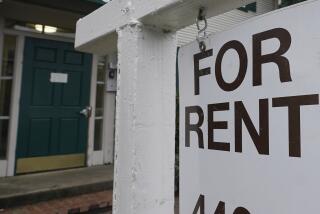Avoid disputes with an inventory list
- Share via
Question: My tenant moved out and left a dime-sized chip in the kitchen sink. The tenant said the chip was there at move-in, and I can’t recall. Any suggestions?
Answer: I’m assuming you didn’t fill in an inventory checklist at move-in, or this problem would not have surfaced. Without some proof or evidence of the preexisting condition, it will be your word against the tenant’s if you deduct the cost from the deposit. Hopefully, the two of you can work out a compromise, or at best split the cost if neither party can remember or provide compelling evidence.
It’s not surprising that a checklist wasn’t used. Such a list was unheard of back when hardwood and charm were a rental’s main features. But as housing features have become more complex and items more expensive to replace, the need to keep track of details has gained importance for landlords and renters.
About a dozen states now require a move-in and/or move-out checklist for rentals. California has required move-out inspections since January 2003, with the intent to limit security deposit disputes by requiring landlords to inspect the place two weeks before a tenant’s departure. No state move-in inspection requirements exist at this time.
Laws of the land notwithstanding, a well-written move-in/move-out checklist is invaluable for any rental situation.
What should an inventory checklist look like? Several types are available, including a basic version free from the California Department of Consumer Affairs at www.dca.ca.gov/legal/landlordbook. The list details such areas as the kitchen, the living room, bedrooms, baths and hallways. Items such as floor coverings, walls, counter surfaces and ceiling and light fixtures are sub-listed for each room or area. The columns that follow include space for detailing “condition upon arrival” and a spot to “note condition, including existing damage and wear and tear.”
Because most disputes are over wear and tear, a checklist is essential for establishing a baseline.
For example, is the place carpeted? Is the carpeting discolored or stained? Check for fraying or signs of wear, especially in the main traffic areas. Hardwood floors should be checked for scratches or stains.
Don’t forget paint. Not just the condition, but also the color of each room, including type: gloss, semi-gloss or flat. Antique white or eggshell? Disputes have arisen over paint changes, with both sides scratching their heads over original color and condition years later.
The “condition upon initial inspection” portion covers the pre-move-out requirement for some areas, which is undertaken two weeks before the tenant vacates. The Consumer Affairs list suggests: “Note deterioration beyond reasonable use and wear for which tenant is alleged to be responsible.”
The California Assn. of Realtors’ inspection form, available only to its members at www.car.org, goes into further detail. This five-page list is particularly useful when leasing a rental home or condominium. It starts with the frontyard and exterior, then notes condition of landscaping, fencing, sprinklers, timers, walks, driveways, porches, stairs, mailbox, light fixtures and general building exterior.
For the entry, such details as “entry security, screen doors, knobs, locks, switches and outlets” are just a few of the listed items.
In the living room, checking for fireplace equipment is suggested. Bathroom items include the shower door, rail and curtain, and a note to check the exhaust fan. In the kitchen, the list includes giving the garbage disposal a spin, as well as checking all major appliances inside and out.
Especially handy is the move-in choice of “new; satisfactory/clean; and other” (with space for comments provided). There is even a line for noting sink/faucets problems such as chips.
At move-out, a different column provides the choice of satisfactory, other or “D” for deposit deduction. Comments are to be included in the space provided.
Whichever list is used, having a camera ready is vital for documenting condition, and using a coin, such as a dime, can provide scale.
When is the best time to bring out the list?
“I usually give the tenants a few days to settle in,” said Bernard Mittleman of Mittleman Management. Items that need to be repaired should be put on a different list, or noted as repaired on the walk-through.
H. May Spitz is a Los Angeles-based freelance writer. Reader comments may be sent to [email protected].
More to Read
Sign up for Essential California
The most important California stories and recommendations in your inbox every morning.
You may occasionally receive promotional content from the Los Angeles Times.






